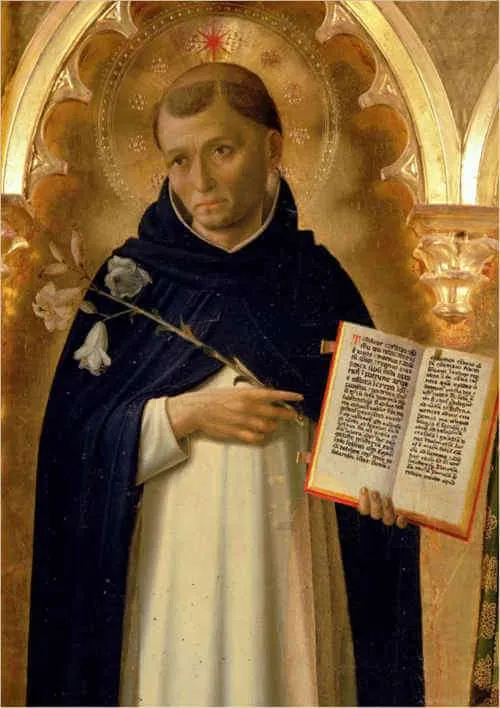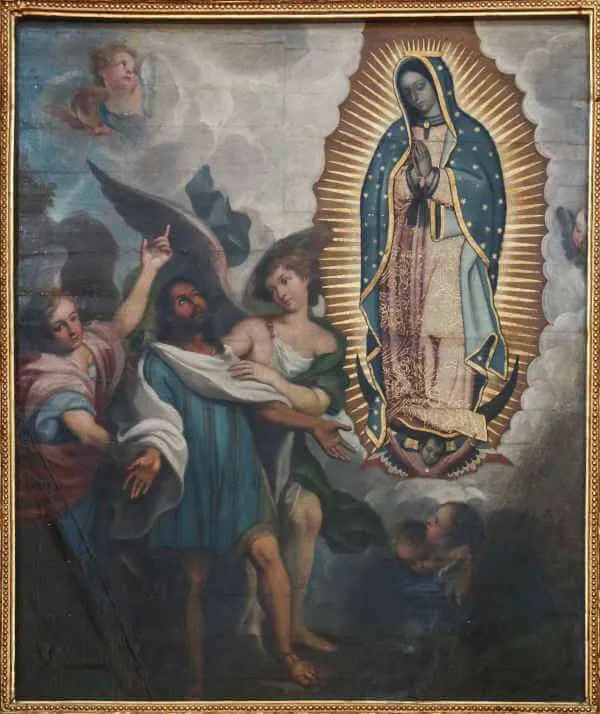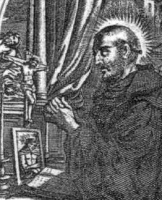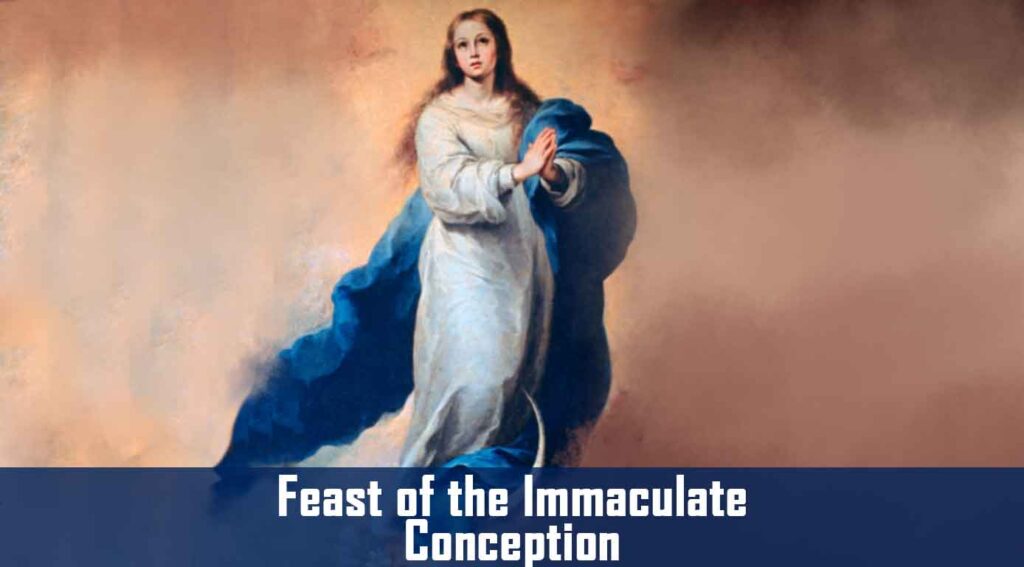1170–1221; Patron Saint of astronomers, scientists, and those falsely accused; Canonized by Pope Gregory IX in 1234
Dominic was born in Caleruega, in the Kingdom of Castile, present-day Spain, to noble parents. He was likely named after Saint Dominic of Silos, a local saint from the previous century. An early biographer relates that his mother, struggling to conceive a child, made a pilgrimage to the monastery where Saint Dominic of Silos had been abbot. Around that time, she dreamt of a dog emerging from her womb that ran around carrying a torch, setting the world on fire. The name “Dominic” can be translated as “The Lord’s Dog.”
Today’s saint came from a holy family. Dominic’s mother was later beatified, as was one brother who followed Dominic into the Order of Preachers. His other brother was a diocesan priest who lived in poverty and was devoted to the care of the poor and suffering. From the age of seven to fourteen, Dominic was educated under the guidance of his mother’s uncle, a priest. From fourteen to twenty-four, he attended the University of Palencia where he excelled in his studies. During his ten years at Palencia, Dominic was also deeply devoted to the poor. On one occasion, he sold all he had, including books he had copied by hand, to alleviate the suffering of those affected by a plague. Twice, he attempted to sell himself into slavery to assist those held captive by their Muslim captors.
When Dominic was twenty-four years old, the Bishop Diego de Acebo of Osma ordained him as an Augustinian canon of the cathedral, hoping that Father Dominic would help reform the other canons. For the next nine years, Father Dominic lived a life of deep prayer, was named sub-prior and then prior, and gave great witness to others through his holy life.
In 1203, the King of Castile sent Bishop Diego on a diplomatic mission. The bishop asked Father Dominic to accompany him on the journey. During their travels, they became aware of two grave needs within the Church. First, they discovered many people in northern Europe who had yet to hear the Gospel’s saving message. Second, they encountered a heretical group in southern France called the Cathars, who were leading many astray. After completing their diplomatic mission, Bishop Diego and Father Dominic detoured to Rome to consult with the pope. After their consultation, the pope sent them back to southern France to assist with the conversion of the Cathars. The Cathars followed a form of the Albigensian Heresy, which taught that there were two gods: one good, associated with the New Testament and the spiritual world, and one evil, associated with the Old Testament and the material world. They believed that the goal of life was to escape the evil of the material world and live a purely spiritual life, achieved by a rigorously ascetic lifestyle.
Previously, the pope had sent Cistercian monks to convert the Cathars. However, the Cathars lived an extremely ascetic life while the Cistercians did not, leading the Cathars to reject the Cistercian intervention. Encountering this firsthand, Father Dominic understood that the best way to combat the heresy was to form an order that lived in extreme asceticism yet remained true to the faith of the Church.
Back in southern France, Father Dominic and Bishop Diego worked tirelessly to rescue souls from the Albigensian heresy. They did so by engaging in public debates and private dialogues with the Cathars, hoping to convince them of their errors through reason and persuasion. Father Dominic and Bishop Diego lived in poverty as itinerant preachers, possessing only the Gospel. After Bishop Diego died, Father Dominic founded a convent in Prouille in 1206 dedicated to Saint Mary Magdalene. The purpose of the order was twofold. First, Father Dominic believed that it was through prayer, above all else, that souls would be saved. Second, the convent provided a safe haven for women and nuns who were converted away from the Albigensian heresy. The convent also provided for the education of girls, giving parents an alternative to the heretical convents for their daughters’ education.
Over the next several years, God performed a number of miracles through Father Dominic. Some of those miracles resulted in conversion and new followers. As time went on, Father Dominic began to write a rule of life for himself and his companions. In 1215, with the permission of the Bishop of Toulouse, Father Dominic founded a new order of men, dedicated to evangelization through prayer, study, and poverty. Like the newly formed Franciscans, they sought to institute a new form of religious life. They did not live as monks, canons, or diocesan priests. Instead, they lived a combination of the three. They lived communally; prayed together; embraced poverty, obedience, and chastity; studied the faith; and then set out on missions of preaching and evangelizing, later returning to their community house where they remained grounded and were renewed in their mission. The following year, Pope Honorius III gave formal consent to the order. Thus, the Order of Preachers, also known as the Dominicans, was established.
The Order of Preachers quickly became a huge success due to the humility, patience, and dedication of Father Dominic and his friars. Miracles also made a difference. One legend states that Father Dominic was invited to a public debate with a leading Albigensian monk. After the debate, the judges could not determine who was victorious so they suggested a test. They were both to place their book of teachings in the fire. The book that did not burn would be declared the winner. The Albigensian went first, and his writings were immediately consumed. When Father Dominic threw his book in the fire, it immediately jumped back into his hand. He did it a second time and a third with the same result. News spread quickly and hearts continued to convert.
In 1217, the pope, impressed with the order’s beginnings, gave Father Dominic the Church of Santa Sabina in Rome as the order’s second home. The pope also elevated Father Dominic to the “Master of the Sacred Palace,” a position designating Father Dominic as the pope’s chief theological adviser. Despite his success, Father Dominic remained a humble and prayerful penitent throughout his life. He slept on the floor, wore a hairshirt, and often walked barefoot when he entered a new town.
In the years following until Dominic’s death in 1221, other houses were founded in Paris, Madrid, and Bologna. After his death, the order continued to expand. By the mid-1200s, hundreds of Dominican houses had sprung up across Europe and even in other parts of the world.
As we honor Saint Dominic and the Order of Preachers, ponder his patience and dedication. In working with the Albigensian heretics, he was neither condemning nor harsh. Instead, he immersed himself in prayer and study, and then made himself available to each person he encountered, listening, discussing, reasoning, and helping to open the eyes of many. His prayerful and humble spirit, coupled with his wise words, saved many souls. Know that God calls you to a similar vocation. Each of us must long for the salvation of souls above everything else in life. Once we are filled with that longing, we must then dedicate all we are and all we have to that mission. Nothing else in life is more important because nothing gives God more glory than rescuing one soul from sin and hell as Saint Dominic did so well.
Source: https://mycatholic.life/saints/saints-of-the-liturgical-year/8-august-saint-dominic-priest/







